It might have gone under your radar, but Canadian Unity and the federal government were delivered a crushing blow last week. The Quebec Superior Court ruled that Bill 99, Lucien Bouchard's response to the Clarity Act, was indeed constitutional.
Of course, you could be forgiven for having missed the news. After all, threats of Quebec separation seem a thing of the past, these days. The Parti Québécois is languishing in 3rd place in the polls, having trouble staying above the 20% mark and are being threatened to be overtaken by the more radical Québec Solidaire. The Bloc Québécois, having failed to gain party status in the last two elections, recently saw 70% of it's tiny caucus slam the door on embattled Leader Martine Ouellette.
But the decision of Judge Claude Dallaire is not only confirming the constitutionality of the Quebec law, it is the defeat of the Federal response to the 1995 near-death experience, which under the guidance of Jean Chrétien and Stéphane Dion, led to the adoption of the Referendum Clarity Act.
The hard line approach, which started with the Secession Reference to the Supreme Court of Canada in in August 1998, had one goal: prevent any future Quebec government from holding another referendum by all means possible. Chrétien and his crew assumed that the Supreme Court would side with the Federal Government's position. Doesn't the Tower of Pisa always lean the same way?
Instead of declaring that a referendum had no legal value and no capacity to break up the federation, the Supreme Court recognized that it has a democratic value. In many ways, the Supreme Court ruling sends the whole thing back to politicians they would have to agree on the follow-up to be given to a referendum on secession, including an obligation to negotiate in good faith by all the partners of the Canadian federation. One guideline provided by the Court: any such referendum needs a clear majority on a clear question.
Cue the Clarity Act. While it is based on the Supreme Court's ruling, it is anything but clear. The concepts of clear majority and of clear questions are not defined. What the Clarity Act did is give the power to the House of Commons to determine, after the fact, whether the question was clear enough and whether the majority obtained was large enough for the result to be accepted. The Chrétien Liberals decided they would give themselves the power to unilaterally change the rules of the game, after the game. And the game had been played twice already!
Many separatists urged the PQ government to challenge the Clarity Act in Court, but instead, the Quebec Government responded by adopting Bill 99: an Act respecting the exercise of the fundamental rights and prerogatives of the Québec people and the Québec State. A Court challenge would have taken years and been very costly. Bill 99 established the rights of the National Assembly to determine unilaterally how to exercise their right to choose their political regime, including sovereignty, and that the winning option in a referendum is whichever obtains 50% of the votes, plus one.
Since Quebec wouldn't challenge the Clarity Act, the ball was in the Federalist camp to decide if they would go to Court. And it was one of the smallest players who picked up that ball: Keith Henderson, the last leader of the now defunct Anglo-rights Equality Party. This forced the Quebec Government, under Jean Charest, to defend the Quebec law. A few years later, the Attorney General of Canada under the Stephen Harper government joined the fray. And here we are, 15 years later.
The Federal Government pleaded that Bill 99 didn't allow for a unilateral declaration of independence. The Superior Court considered the facts: "Could it be that by enacting Bill 99, [Lucien Bouchard's government] tried to set the table to separate unilaterally from Canada […]? The answer is no. We must therefore put things in perspective and get out of the thesis of the plots of war implemented by the separatists, in order to reduce ourselves for a moment to reality, " wrote Judge Claude Dallaire.
Speaking of reality, in her ruling, Justice Dallaire validates the 50% + 1 threshold as a clear majority. There is nothing unconstitutional about it, she ruled, and since the Supreme Court did not identify what a clear majority was, since the Federal government failed to define it, since it's been the threshold used in the past, "there is nothing new under the sun". 50% + 1 stands.
And of course, it does. Despite the rhetoric, in our legal system, a referendum is only advisory and actually non-binding: the real decision-making powers remain the prerogative of parliamentarians. Politicians can always choose to ignore the results, just like PEI Premier Wade MacLauchlan did after ignoring a vote in favour of a switch to proportional representation. So Quebec could ignore a Yes vote.
But Ottawa couldn't. If the Quebec government triggered and won a referendum, Justice Dallaire, like the Supreme Court did 20 years ago, confirmed the requirement for political actors to negotiate in good faith for a constitutional amendment recognizing the secession of Quebec.
Alas, good faith is not exactly what's been driving this entire saga.






